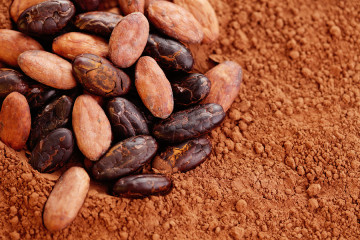In Cocaine-to-Chocolate Shift, Market Forces Lend a Helping Hand

©2015 Bloomberg News
NXODN16K50Y6
(Bloomberg) — It was the murder — execution-style, in broad daylight — of a friend and fellow farmer in the Colombian countryside that prompted German Sanchez to finally heed government calls to get out of the cocaine trade and plant cocoa instead. Six years later, market forces, more than concerns about personal safety, are persuading him not to switch back.
Prices for cocoa, the raw material used to produce chocolate, are climbing in international markets, lining the pockets of Andean farmers. Sanchez says he’s getting about 6,800 pesos ($2.31) this year for a kilogram (2.2 pounds) of cocoa beans, compared with 5,000 pesos last year and about 3,000 pesos in 2012.
Coca, the source of cocaine, “caused a lot of bloodshed,” said the widower, a father of two. “Family members were killed and others ended up in jail. The economic revenues didn’t justify the risk.”
Cocoa futures have surged 39 percent in the three years through Nov. 10, according to data compiled by Bloomberg. The Bloomberg Commodity Index, which doesn’t include cocoa, tumbled 40 percent in the same period.
The trend partly reflects supply constraints in West Africa, which accounts for about 70 percent of the world’s supply. Dry weather from the strongest El Nino since the 1997-98 record has hurt crops there — mainly in Ghana, the No. 2 producer — although the return of rainfall last month eased some of the concerns.
Even so, the 2015-2016 crop in Ivory Coast, the No. 1 producer, will be smaller than last year’s record of 1.8 million tons, and El Nino continues to pose risks in Indonesia, the No. 3 grower, and Ecuador, Rotterdam-based trader Cocoanect BV said in an e-mailed report.
Old trees, disease and a younger generation reluctant to follow their parents into the fields also keep supplies tight as demand rises. Global cocoa bean use will outpace crops by about 96,000 tons in the 12 months ending Sept. 30, 2016, based on estimates by the International Cocoa Organization in London. The chocolate market will grow to $115 billion by 2020 from about $50 billion in 2001, Euromonitor International projects.
All this is supplementing years of effort by governments and organizations in the U.S. and South America to reduce coca cultivation. The illegal crop is grown exclusively in the Andean region, with Peru accounting for about 39 percent of cocaine production, Colombia 33 percent and Bolivia 28 percent. The final product typically ends up in Europe and the U.S., the biggest consumers, according to the U.S. Office of National Drug Control Policy.
The U.S. Agency for International Development began its alternative development program in Peru 20 years ago. Since 2002, it has invested $620 million assisting the country in replacing more than 80,000 hectares (198,000 acres) of illegal coca with legal alternative crops, including cocoa, said Gregory Swarin, USAID regional program officer in Lima.
Farmers are on track to plant an additional 28,000 hectares of fine and aromatic cocoa with help from a three-year plan started in 2013 by the Peru Cocoa Alliance, a $36 million public-private partnership supported by USAID, Swarin said.
Exports Up 57%
The value of Peru’s cocoa exports rose 57 percent to $247 million in 2014 from a year earlier, according to ADEX, the nation’s exporter group. Government data show that production may double by 2020 from this year’s projected 80,993 tons.
Reyes Mulatillo, 36, is contributing to the increase. With the help of the USAID and a local group, he abandoned coca for cocoa three years ago — to his wife’s relief, he said in a telephone interview from the town of Tingo Maria, in the country’s Huanuco region. He now has one hectare planted with premium beans and expects to reap more than 250 kilograms this year, his first crop.
“We wanted a legal product and a more peaceful life,” Mulatillo said.
The Colombian government started its alternative development program 10 years ago, with support from the United Nations Office on Drugs and Crime, or UNODC. About 54 percent of total cocoa plantings in the country — 58,886 hectares — are in areas where illegal crops once grew, according to government data.
Rising Production
The shift has helped to boost Colombia’s cocoa production 11 percent to 54,120 tons in the 12 months ended Sept. 30 compared with the previous season, data from the Bogota-based National Federation of Cocoa Growers show.
German Sanchez, president of his local association of cocoa producers, switched to cocoa beans with the encouragement of the Colombia government program. The Valdivia, Antioquia, farmer now has three hectares, about same as he once planted with coca, and expects to reap 120 tons of the beans in 2016, up from 60 this year. A recent loan through his association, Asocaval, from Banco Agrario de Colombia SA will allow him to add 1.5 hectares of the safer crop.
The support for legal crops — and farmers’ concerns about the violence and insecurity associated with cocaine — helped cut combined coca plantings in Peru, Colombia and Bolivia to 120,000 hectares in 2013 from a year earlier, the lowest since the mid 1980s, according to the UNODC World Drug Report 2015.
Some farmers are sticking with the illegal crop, partly because the reduction in plantings caused the price of coca leaves to rise in certain regions. Cultivation in Colombia rose 44 percent in 2014, to 69,000 hectares, from 2013, according to a July 2015 UNODC report, which noted the expanse was mainly in communities that already grew coca.
Pedro Suarez quit coca in 2000 and hasn’t gone back, citing dangers that include its link to the conflict that involves rebels and paramilitaries. He began sowing cocoa beans six years ago and is now the president of his local cocoa association in Topaipi, Cundinamarca, with three hectares.
A park ranger sponsored by the UN for security is giving him confidence to stay with cocoa, along with the price of the crop, which “has improved a lot,” he said by telephone. It’s “giving people the morale boost to keep planting.”
–With assistance from Andrew Willis in Bogota.
To contact the reporter on this story: Marvin G. Perez in New York at mperez71@bloomberg.net To contact the editors responsible for this story: Simon Casey at scasey4@bloomberg.net Melinda Grenier






No Comment